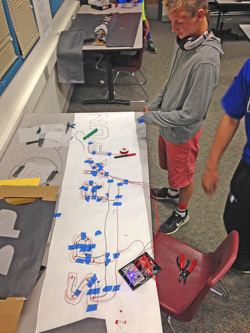SparkFun Stories of Success
Inspiring Students to Learn
Danny Hernandez, Teacher, Westview Middle School
St. Vrain Valley School District, Longmont, CO
How one teacher got middle-school students introduced to coding.
“The amount of creativity and critical thinking that is involved with the [SparkFun Inventor’s Kit] and Arduino is beyond what I imagined,” he said.
Westview Middle School teacher Danny Hernandez found the SparkFun Inventor’s Kit and his students found out the foundation of coding. He started using the kit with his students in 2014, following the SIK guidebook to cover the basics of programming with Arduino as well as building circuits.
However, after a few years of this approach, Hernandez noticed that some students picked up on the concepts covered in the SIK faster than others. In order to allow all students to work through the kit at their own pace, he decided to create some video tutorials.
Project-Based Learning

Now, Hernandez takes students through the first few circuits over the course of a few weeks and then sets them loose to learn at their own pace. Once students demonstrate understanding of the first few circuits, they are challenged to either work their way through the rest of the guidebook or create a project with the knowledge they already have.
Hernandez says many students choose to create a project, at which point the learning becomes individualized based on what they need to know in order to bring their ideas to life. With this project, students are allowed to build whatever they want, as long as they can figure out how to program it.
As Hernandez puts it, “The amount of opportunity with this kit is ridiculous (in a good way). There is so much the kids can learn and so many projects they can do.” The range of projects students have created with the SIK is just as diverse as the students creating them. Here are a few examples from Hernandez’s class:
Seeing Results
What do the students think of this approach? Hernandez says the kids love it! They come in every day and get right to work.
Best of all, the things they learn in Hernandez’s class are translating into their other coursework. “These kids are learning that one simple little mistake like ledPin vs. ledpin will mess up their whole code,” he explains. “It is translating over to their core classes and how they need to pay attention to their work at all times. Some teachers have mentioned tougher kids and kids who have struggled with grades are starting to perform better as they are being more careful with their work.”
Advice for Others
While the skills students gain from learning to code, such as attention to detail, are easy to replicate, Hernandez admits his approach may not work for every educator. He cautions that approaching the class the way he has, allowing students to learn at their own pace, requires patience and being comfortable with disorganization. While student have told him they love having the opportunity to work at their own pace, the various projects throughout the room leave it in a state of “constant organizational nightmare.” However, Hernandez sees this as the price for inspiring students, saying “it is proof that some really good learning is going on daily.”